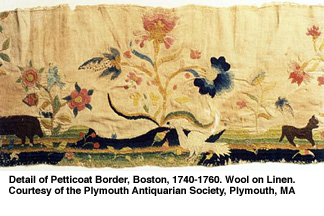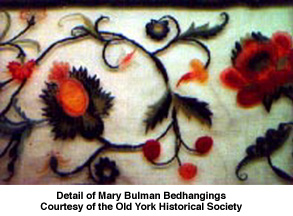
It is interesting that embroidery, the end result of enslaving
women to a needle, has become a means of expression for women
in the 20th century who may never have held a needle previously
in their lives. This has ironically coincided with this century's
women's movement that repositioned women from an extension of
a male to an individual. At a time when homemaking skills are
low in priority, more women have rediscovered the needle, advancing
embroidery skills and knowledge further than the previous generations
of this century.
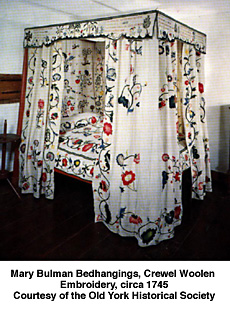
The crewel revival of the 1960's and 70's began mildly enough
with Mildred Davis and Elsa Williams. Their discoveries and love
of crewel focused attention on textiles preserved in museum collections
for women who were still homebound. Erica Wilson, with her design
ability and skill, represented a new freedom that was arriving
quickly. When Susan Swan's book, Plain and Fancy, reached
this market in 1976, a passion was flamed for textile research
and study that continues today. Betty Ring's monumental work, Girlhood Embroidery, opened the past for many women who
could clearly feel a connection to their history through embroidery.
This excitement is reflected in amazing advancements in counted
work on evenweave linen by women relearning 17th century techniques
who are no longer bound by previous conventions. Crewel embroidery
has had many revivals since its English and American zenith of
the 17th and 18th century. Each revival alters and redefines
stitch names and techniques with losses and gains sustained during
each period.
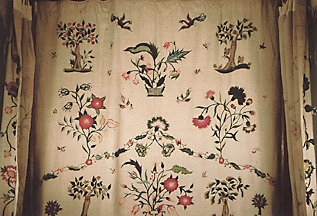
|
Detail from Mary Bulman Bedhangings, Courtesy of
Old York Historical Society
|
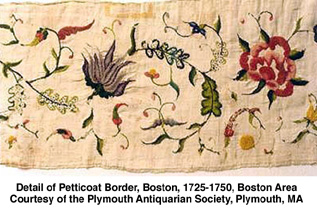
The word crewel, with a variety of spellings, can be found
in English records back to the 13th century. It is thought to
have come from the East to Egypt then to Greece and Rome where
it traveled with the Roman conquests to England. From the 15th
century crewel embroidery meant any embroidery technique using
fine worsted yarns. I've been known to say repeatedly that the
name surely refers to the effect of the sharp needle on your
fingers while stitching. This is definitely an untruth for past
usage of the word crewel included tent and cross stitch using
an inoffensive tapestry needle. By the 20th century crewelwork
had been redefined to mean surface embroidery with wool. Crewel,
by definition, is the application of a variety of stitches to
the surface of fabric, usually linen, following a design applied
to the fabric.
CLICK
HERE FOR PAGE
2 CONTINUATION
OF THIS FEATURE


